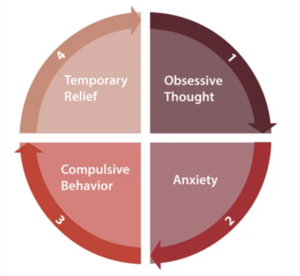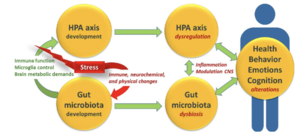The Gut-Brain Axis and OCD: Difference between revisions
No edit summary |
|||
| Line 46: | Line 46: | ||
<br>Humans have developed a symbiotic relationship with the up to 40,000 species of bacteria that live in their digestive tract. The presence of microbes in the digestive system is necessary for survival and a specific balance of organisms is required for proper functioning. Dysregulation of the gut microbiota has been closely correlated with anxiety disorders, one of which being OCD. Two primary mechanisms that are hypothesized to cause or worsen OCD symptoms are the role of stress on the microbiome and the altering of the microbiome through antibiotics.<br> | <br>Humans have developed a symbiotic relationship with the up to 40,000 species of bacteria that live in their digestive tract. The presence of microbes in the digestive system is necessary for survival and a specific balance of organisms is required for proper functioning. Dysregulation of the gut microbiota has been closely correlated with anxiety disorders, one of which being OCD. Two primary mechanisms that are hypothesized to cause or worsen OCD symptoms are the role of stress on the microbiome and the altering of the microbiome through antibiotics.<br> | ||
{The HPA Axis} | |||
Include some current research, with at least one figure showing data.<br> | Include some current research, with at least one figure showing data.<br> | ||
<br> | <br> | ||
Revision as of 03:28, 18 April 2022
Introduction
By Ali Hatfield
The systems of the human body are connected in many more ways than the average person could think of. At first thought the digestive system, commonly referred to as the human gut, is deeply separated from the nervous system. However, recent research has shown that this is not the case, and there are many more connections between the two than most would imagine. Studies have shown correlations between human gut microbial activity having an effect on psychological well-being, either improving or declining mental health. In cases with a direct connection between gut microbiome and brain activity, this is known as the gut-brain axis. This communication from bowel to brain is bidirectional, with interference in the gut microbiome having the ability to alter the nervous system, and interference with the nervous system having the ability to alter gut activity.
The gut microbiome can affect a variety of psychological disorders, one of which being obsessive compulsive disorder (OCD). OCD is an anxiety related disorder that is believed to affect about 1% of the population, yet the number of diagnoses is hard to perfect in the case of psychological conditions. It is reportedly more frequently found in women than in men in adults (age >18) and more frequently found in boys than girls (age <18). Like many psychological disorders, obsessive compulsive disorder is a condition that displays a wide range of symptoms and manifests itself differently in each person afflicted by the disorder.
At right is a sample image insertion. It works for any image uploaded anywhere to MicrobeWiki.
The insertion code consists of:
Double brackets: [[
Filename: PHIL_1181_lores.jpg
Thumbnail status: |thumb|
Pixel size: |300px|
Placement on page: |right|
Legend/credit: Electron micrograph of the Ebola Zaire virus. This was the first photo ever taken of the virus, on 10/13/1976. By Dr. F.A. Murphy, now at U.C. Davis, then at the CDC. Every image requires a link to the source.
Closed double brackets: ]]
Other examples:
Bold
Italic
Subscript: H2O
Superscript: Fe3+
Sample citations: [1]
[2]
A citation code consists of a hyperlinked reference within "ref" begin and end codes.
To repeat the citation for other statements, the reference needs to have a names: "<ref name=aa>"
The repeated citation works like this, with a forward slash.[1]
Obsessive Compulsive Disorder
Obsessive Compulsive Disorder is categorized by intrusive thoughts or ideas, which are known as obsessions repeatedly occurring in a person’s mind, and often of a negative nature. These obsessions are then followed by the need to perform a type of compulsion to neutralize the feelings of anxiety these ideas spark. The range in content and severity for both the obsessions and compulsions in OCD patients is extraordinarily broad, with some cases causing minor inconvenience while others can be debilitating. Common obsessions often relate to the idea of harm coming to a person with OCD or their loved ones, fear of contamination, embarrassment, or shame, or the need for things to be exact or in order. Compulsions are often a combination of mental acts, such as counting or repeating words, to physical acts, such as checking, cleaning, or rearranging. Cases of OCD can also be considered either more focused specifically towards obsessions or compulsions separately. Some people with OCD may experience more of an issue with the intrusive thoughts or images but not feel as much of a need to complete compulsions to satisfy themselves, while others feel the

compulsion to complete acts to neutralize anxiety that has not been generated by obsessive thoughts. Due to the nature of the disease, it is referred to as one of the most common serious mental illnesses.
OCD onset usually occurs during adolescence, with most people who have it developing it before the age of 25. Despite a higher prevalence of cases in women, onset has shown to occur earlier in men. Comorbidities, in which multiple disorders are present in one person, are exceedingly common with OCD, and the afflictions of one or two other psychological conditions often heighten the symptoms of each other. The highest percentage of OCD cases that present with a comorbidity is with major depressive disorder, which accompanies OCD in approximately one third of patients. Additional comorbidities often seen are generalized anxiety disorder, PTSD, eating disorders, social phobia, and other mood and anxiety disorders.
Historically, the most successful treatment methods for OCD is a combination of pharmacotherapy and therapy. Due to many of its systematic and structural similarities to other anxiety disorders, and frequent comorbidities to depressive disorders, selective serotonin reuptake inhibitors (SSRIs) are a common pharmaceutical treatment for OCD patients, and the combination with cognitive behavioral therapy has shown great management and symptom prevention capabilities. These therapies only aim to target the neurological background of obsessive compulsive disorder by altering brain chemistry and providing exposure to specific fears and anxieties. While these have proven to be beneficial, anxiety disorders often have roots in other parts of the body that may be interesting to look at for therapeutic purposes.
Include some current research, with at least one figure showing data.
Every point of information REQUIRES CITATION using the citation tool shown above.
The Gut-Brain Axis and OCD
Humans have developed a symbiotic relationship with the up to 40,000 species of bacteria that live in their digestive tract. The presence of microbes in the digestive system is necessary for survival and a specific balance of organisms is required for proper functioning. Dysregulation of the gut microbiota has been closely correlated with anxiety disorders, one of which being OCD. Two primary mechanisms that are hypothesized to cause or worsen OCD symptoms are the role of stress on the microbiome and the altering of the microbiome through antibiotics.
{The HPA Axis}
Include some current research, with at least one figure showing data.
Digestive and Psychological Comorbidities
Include some current research, with at least one figure showing data.
Microbial Remediation of OCD
Conclusion
References
Authored for BIOL 238 Microbiology, taught by Joan Slonczewski, 2022, Kenyon College

